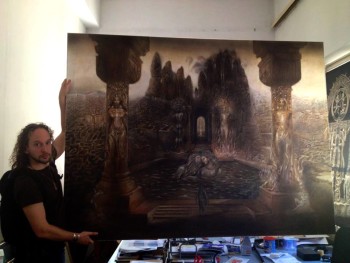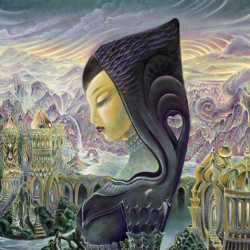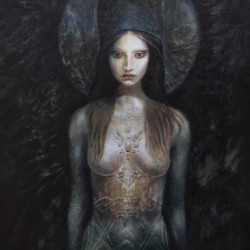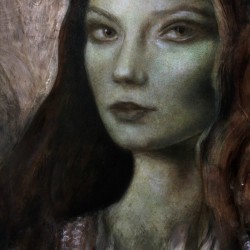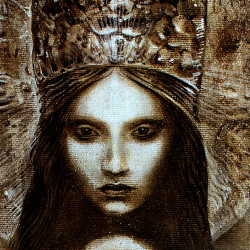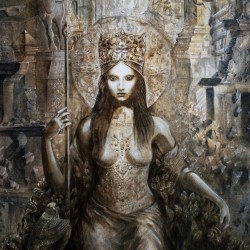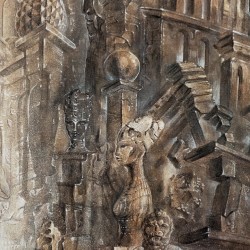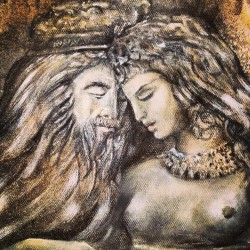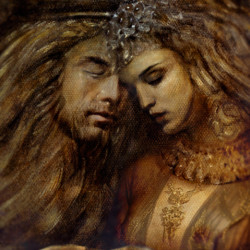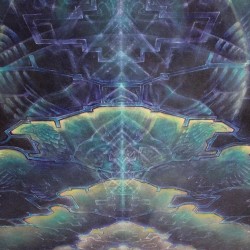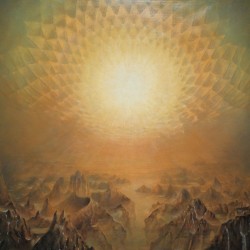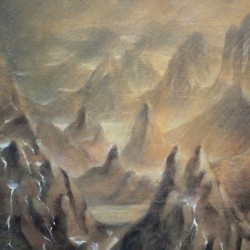I sincerely believe that there are alternative currents to the history of art, and that we are in the very process of revising art history as we speak. Daniel Mirante is becoming one of the great art historians, and one of the great artists, of our times…– Laurence Caruana, Director of the Vienna Academy of Visionary Art
Daniel is a new light on the visionary horizon.– Professor Philip Rubinov Jacobson
Daniel Mirante is a painter, teacher and writer based in the United Kingdom. As well as exhibiting and speaking internationally, he is a member of the founding faculty of the Vienna Academy of Visionary Art and of the UK based Art Pilgrim project. His interest in visionary and sacred art is influenced by intensive ceremonial work within indigenous cultures and mystical lineages.
Q: How long have you been painting, and what was your first memory of the art process?
A: The very first memories I have are connected to the creative process. I remember drawing an alien landscape on the floorboards of my parents bedroom when I was very small. I remember my mother and father walking in and the look of surprise on their faces. Later, still quite small, I remember drawing many labyrinths, interconnected realms and portals. These were like bridges to my dreamworld, manuscripts to connect or map places I’d visited. They were blown into the ocean, many pages, when my grandfather took me fishing. I remember an anguish, like an alchemist loosing his treasure maps.
Q: Have you been trained, and if so from what institution? Or are you self taught?
A: I spent a long time finding my own way with oil paint and the so called ‘mischtechnik’, famed in visionary art circles, a labor-intensive method mixing layers of egg tempera and oil glazes. I have been very fortified by encounters with master craftspeople, such as Brigid Marlin, who’s work I discovered on the internet in 2004 and was through whom I encountered the visionary art movement. She was also my first guide with oil painting. And then assisting the fantastic realist Ernst Fuchs in 2012. Ernst is someone who teaches through transmission and dreams. Michael Fuchs also dispensed some potent advice that gave me keys to open further levels of self-learning. The restoration community and museums also are good places to learn about renaissance painting techniques.
Q: What inspires your creations?
A: Life, existence, is an unfathomable and beautiful mystery. This inspires me… because this is all there is. Great heroes and explorers, magicians and saints, the beauty of the human body, the sacred feminine, and nature also count as deep inspirations for me – the ancient patterns of the human life that guide us to grow, across initiatory thresholds.
On a broader level, I feel art has a vital role to play in a culture becoming more secular, more disenchanted, to hold a kind of balance between the rational or factual, with the imaginal and intuitive. Art is a means to explore and reveal a deep and intimate spiritual correlation between our selves and the greater world. The tension or ‘marriage of opposites’ inspires my creations.
Q: Was your family supportive of your artistic endeavors?
A: Always. My family has a deep appreciation of mountains, lakes, forests, birds and animal life. I am of celtic and hyperborean ancestry so these roots are deep, I feel. The austere ancient landscapes of the north, with their exposed granite peaks, mossy forests and clear running streams, lakes and rivers touch my soul, and these are environments my family helped me access as a young child. As well as this, cultural heritage such as temples and museums are something my family also appreciated.
Q: Is there someone special who has encouraged your work and your path as an artist?
A: There have been several initiations, from people both distant and intimate. The muse manifests in different forms in different times. Sometimes the muse is nurturing, encouraging, sometimes the muse is a destructive and re-creative force. The muse appears in novel forms, rarely predictable.
Q: What are your hopes and dreams or future goals?
A: My dreams really are for humanity to change their orientation from a ‘setting sun’ world of economic and environmental decline, toward a collective movement of regeneration of the biosphere and the development of a culture of honoring, where children can be raised without fear of violence, and are given space to play and discover, and learn through exploration of nature, and where grown men and women are no longer shackled to ingrained patterns around the exploitation of sexuality and status, where we detoxify from the trivial and life-denying effects of mass consumerism, and instead work together toward the healing and improvement of the world, for all life. A vision whereby each generation can live to see more beauty, more healing, more freedom.
However in my own personal scope, in terms of my hopes for my craft, I dream to bring my increasingly narrative-based visions into a form like story-book, screenplay and film. I have experimented already with translating one painting into a narrative, which can be seen at http://youtu.be/CL6gf3Dgjxg
Q: If you could meet any artist who is no longer living, who would it be and why?
A: I would love to have met J.R.R Tolkein. There are two particular things I admire and find very important about his work. Firstly is the genuine, deep connection to the culture, to history, to the egregore or ‘spirit of the land’, which forms the spirit of the culture upon those lands, and the languages and myths of the people of the lands. Then there is his concept of ‘sub-creation’ whereby he regards human creative activity as a ‘God given’ power which brings us very close to the action of bringing-forth-a-world, of participating in creation, and not just of this world, but ‘the world to come’ in terms of the spiritual dimension. So his vision of creativity requires deep roots in order to support great heights. I would love to talk to him more about these subjects, as I feel such orientations – toward land, remembrance of deep spiritual and ethnic culture, as well as creativity understood as a divine gift, could transform art, especially visionary art. Such an investigation is the intention of the retreats run by myself and Judith Way at www.artpilgrim.org
Q: What does Visionary art mean to you and why were you drawn to do this work?
A: Sacred texts and images contain highly developed and profound symbolic lexicons. But they are like stained glass windows – they need illuminating to come to life. So many people scrutinize the words of The Bible, for instance, but it is more important to scrutinize the very listener.
Sacred texts and images and their symbols are a participatory dialog with ones own consciousness. Sacred texts and images are very deep, they are poly-valent – their meanings can arrange themselves in many different ways according to our own state of being. This is possible because symbols resonate on many levels of the psyche according to the state of the listener. The rose is the temporal image of the eternal rose, which is always blossoming, in beauty, life and fragrance.
Being someone drawn to fantastic myths and imagery because of the symbolic language used, I was drawn to visionary art for the possibility to work with symbols and constellate them in ways that tell stories, stories that open up possibilities for those that choose to interact with them. But in order to create these constellations, one has to be attuned or have a living connection to that which one wants to evoke. So it becomes an initiation.
Q: If you had the power to change the world, what would you change?
A: I would wish for less suffering on earth, and that our species moves toward an era of regeneration of the biosphere, of diversity, of great breakthroughs in medicine and healing, and sustainable harmonious food production, and a happy and secure way of life for every being. However, to have such power to ‘change’ all this, would somehow mean I could change peoples consciousness against their current will. Who could say they are wise enough to handle such power? Even if I asked for peoples fear and pain to be extinguished, would this mean I would be interfering in some fundamental aspect of what it means to be human? I feel we have to all work together, each person responsible, to do the work in our own consciousness, in our own hearts to move toward a peaceful and regenerating world.



